OCZ RD400 SSD Review - Citius, Altius, Fortius
Need more gold! (C) WarCraft III
What does the user want? Speeds, and the more, the better. Manufacturers of video cards and processors are successfully satisfying the thirst for speed among enthusiasts, and with storage systems it is traditionally not so simple.
Yes, SSDs are faster than HDDs. Yes, after SATA II, SATA III appeared and everyone became more fun. Yes, they even started making PCI-E drives, but they either left the AHCI protocol or the price of the device so that you can buy a TV and PlayStation 4 ...
However, there are glimmers of hope - OCZ RD400 - PCI-E or M.2 has a form factor, The NVMe protocol supports and costs significantly less than a cast-iron bridge across the Caspian Sea. About him (SSD from OCZ) and talk about it under the cut. I'll start with the characteristics. Miracle how good a new drive is - everything is fine with it - and reading, and writing, and even a rewrite resource.
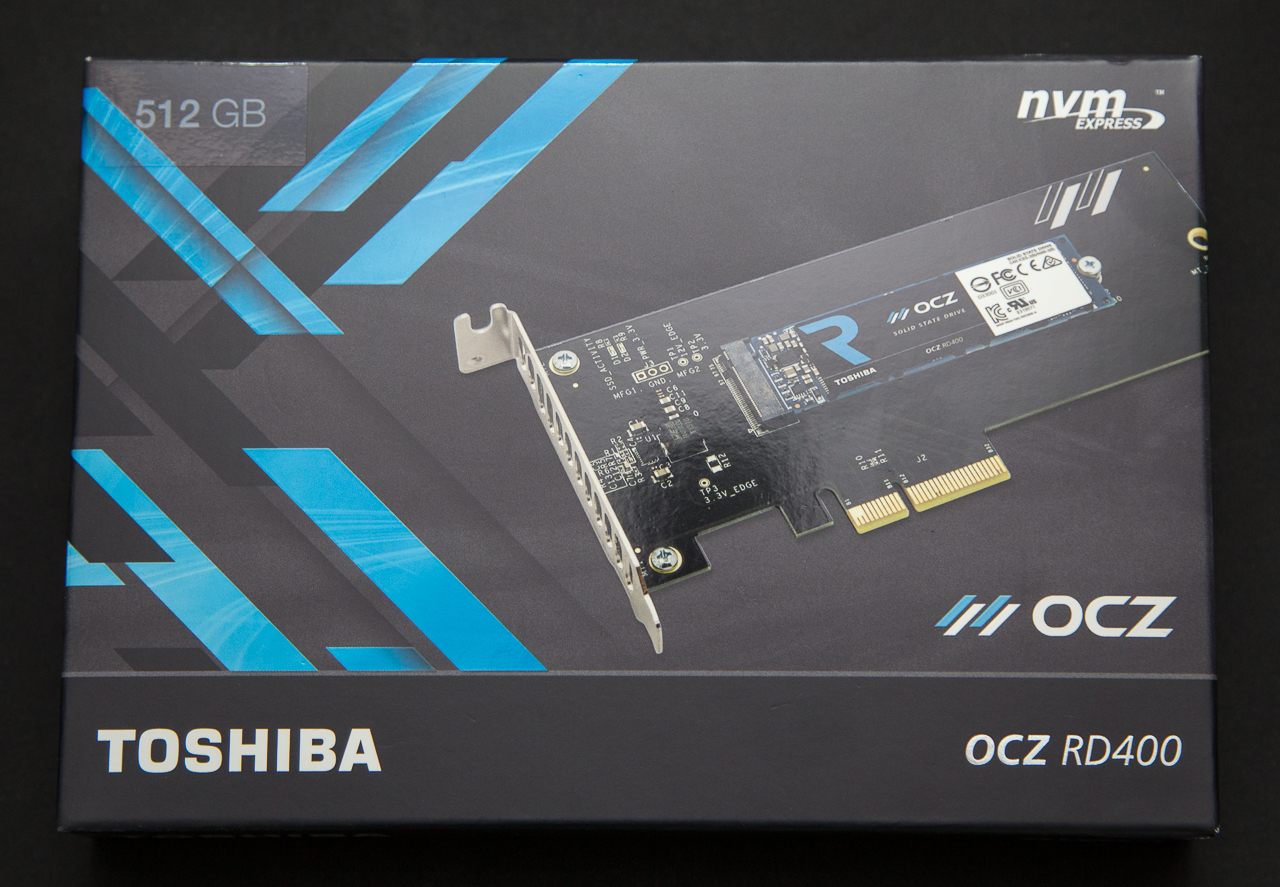
In my hands was a 512 GB SSD. According to the specifications, it is the fastest in linear read / write operations, and slightly inferior to a terabyte disk in random access.
The dubbing resource is 296 TB, or approximately 162 GB per day. During the tests, this figure was repeatedly exceeded, however, such an extreme for SSD is unlikely to suit all users.
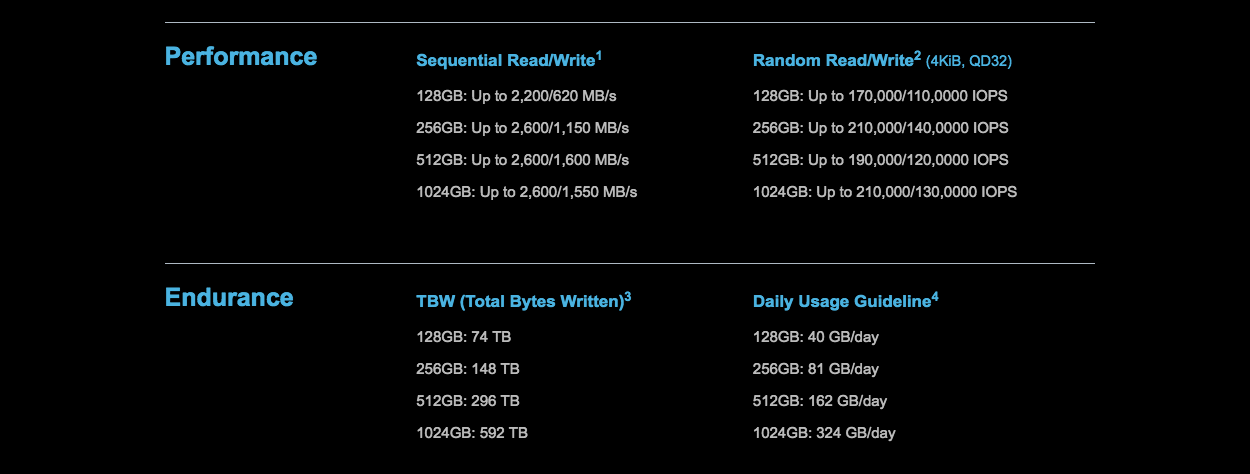
Now the slides:
This is what the box with the OCZ RD400 looks like.

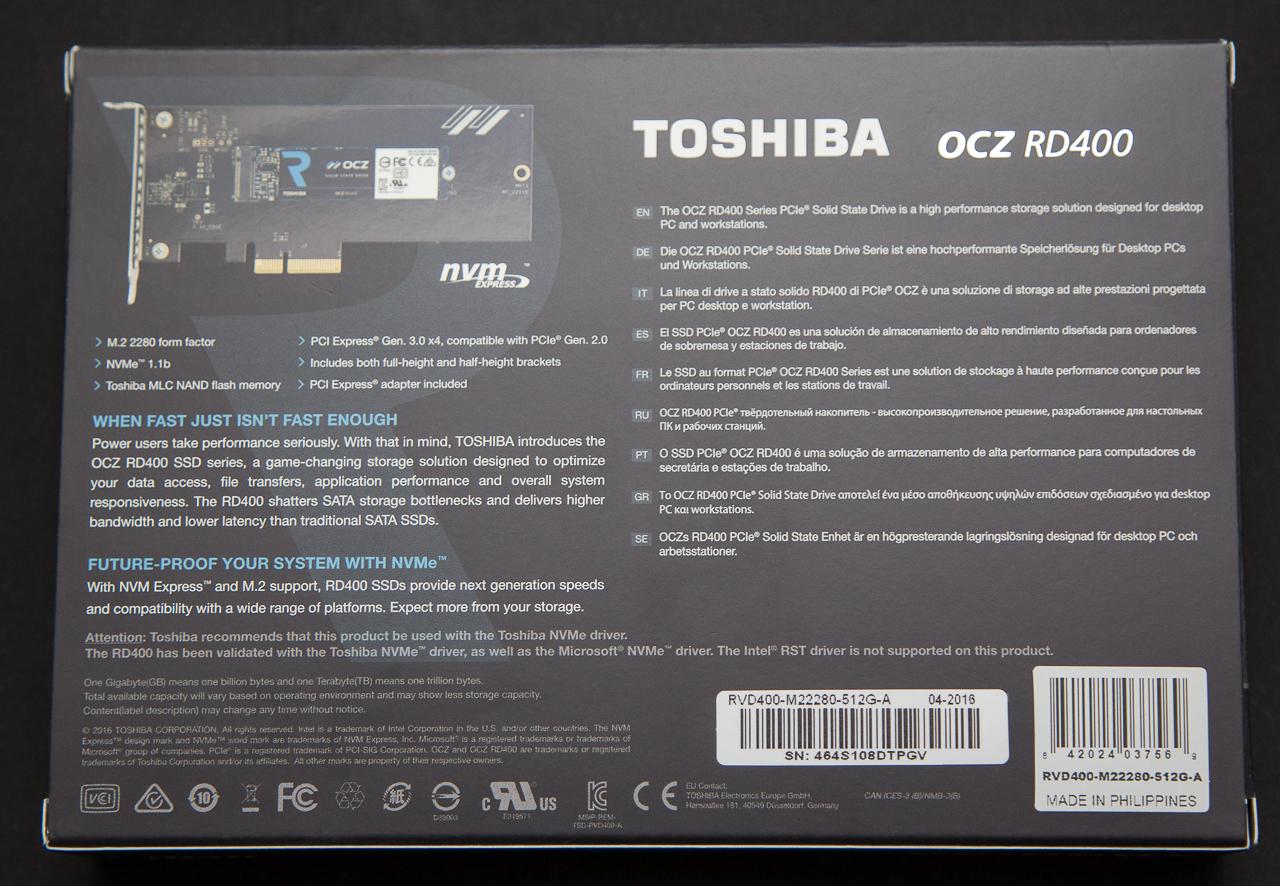
This is what the SSD looks like, which is inserted into the adapter from M.2 to PCI-E x4, which lies in a plastic blister, which lies in a cardboard box.
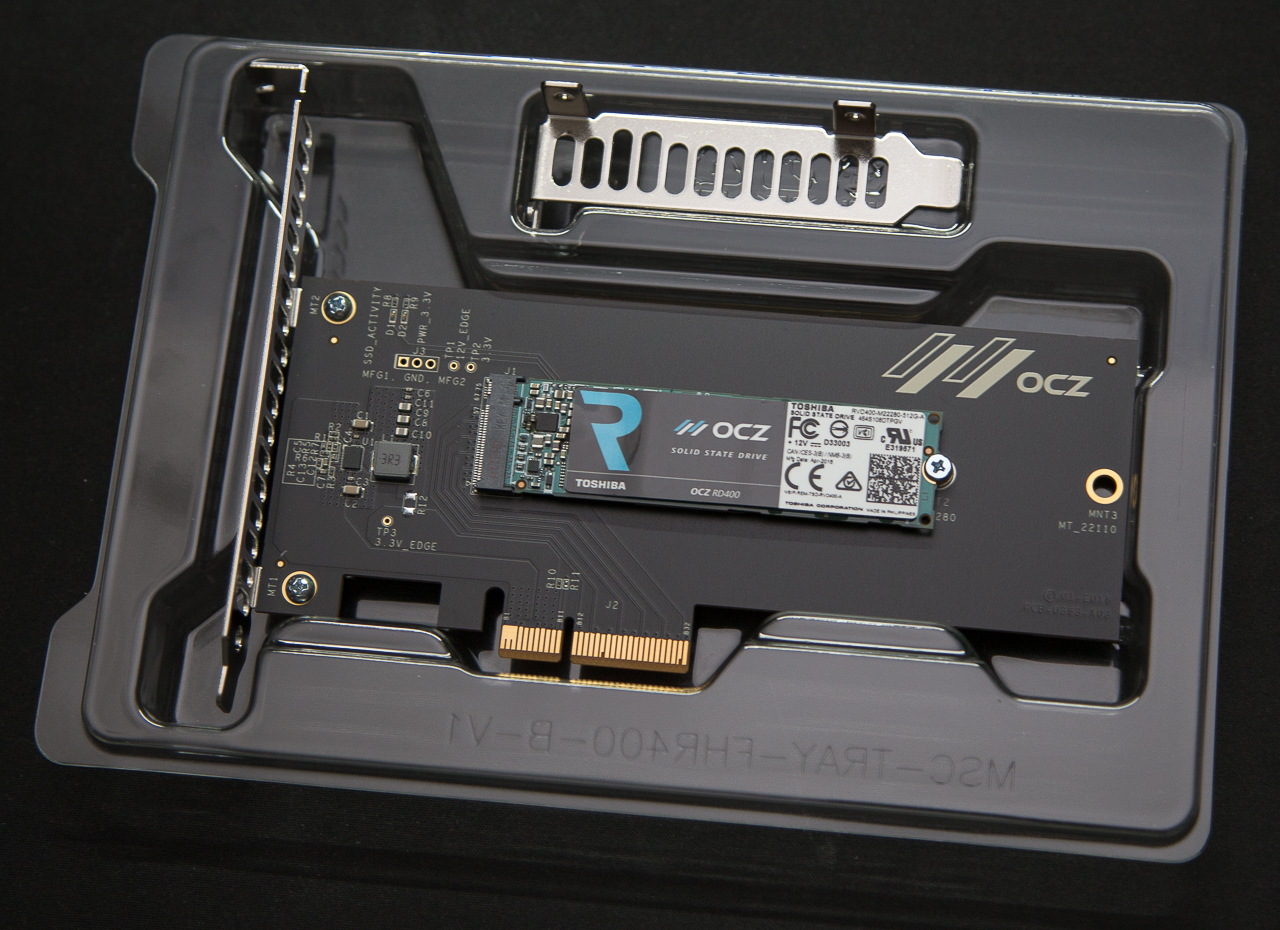
Included is a brief instruction manual.
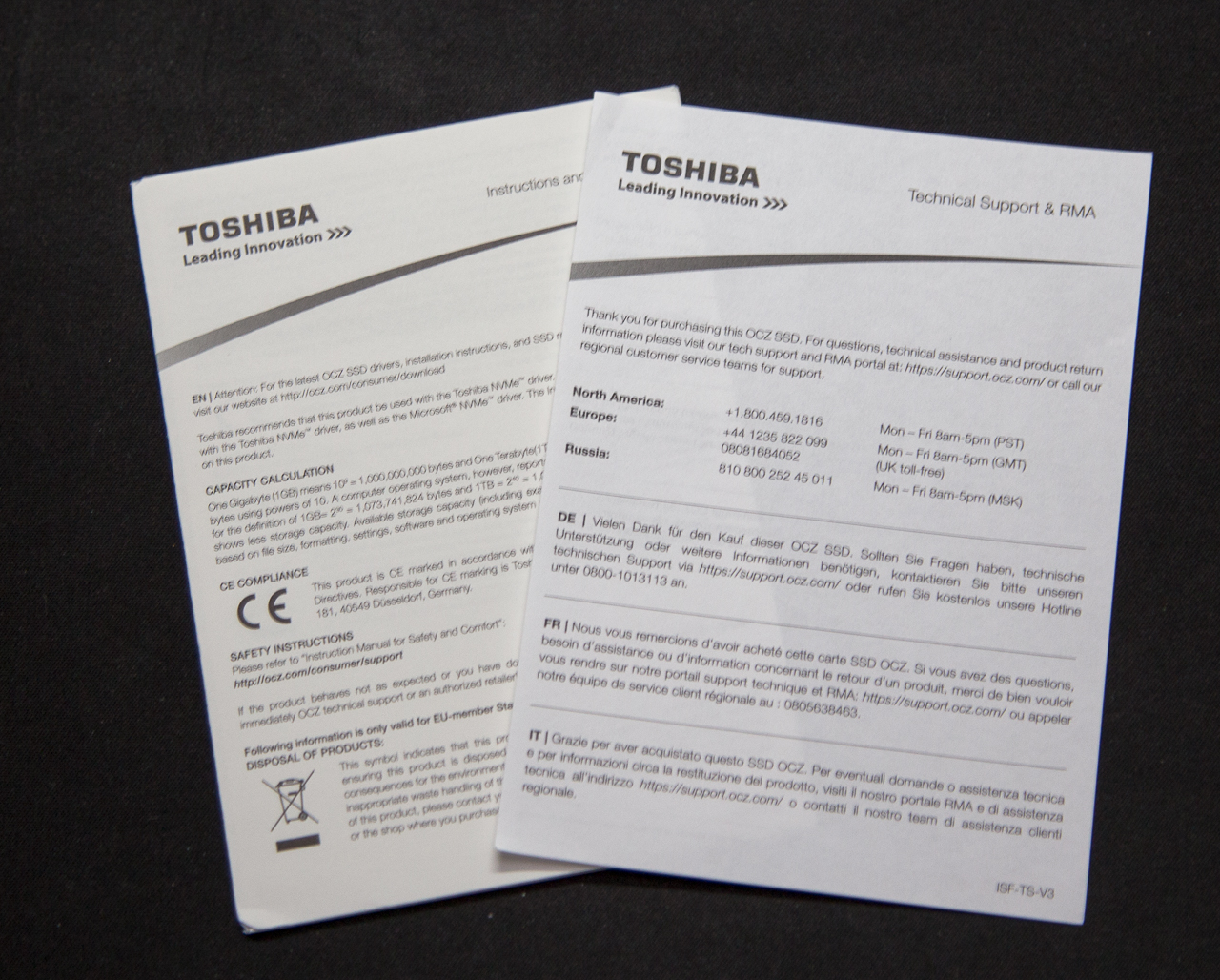
It is possible to install the drive in a low-profile or unit case; for this, the OCZ has an additional bracket.
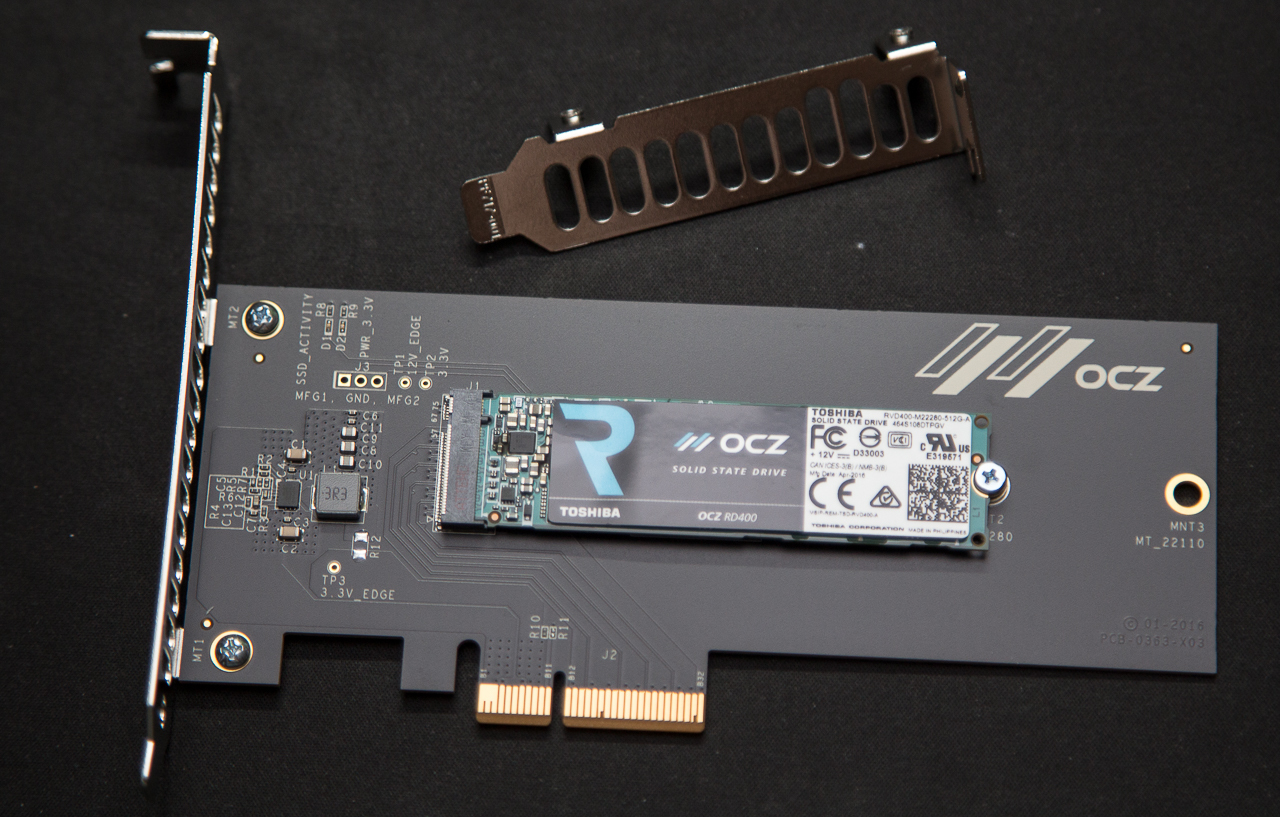
It’s explicitly stated on the drive that it was manufactured at Toshiba’s facilities, but this is a secret of the Open, and I don’t want to discuss the millionth time a deal to buy OCZ.

The adapter simultaneously performs the function of heat removal, but this is a safety measure, because when installed in the M.2 slot, there are no thermal pads and the disk is functioning normally.
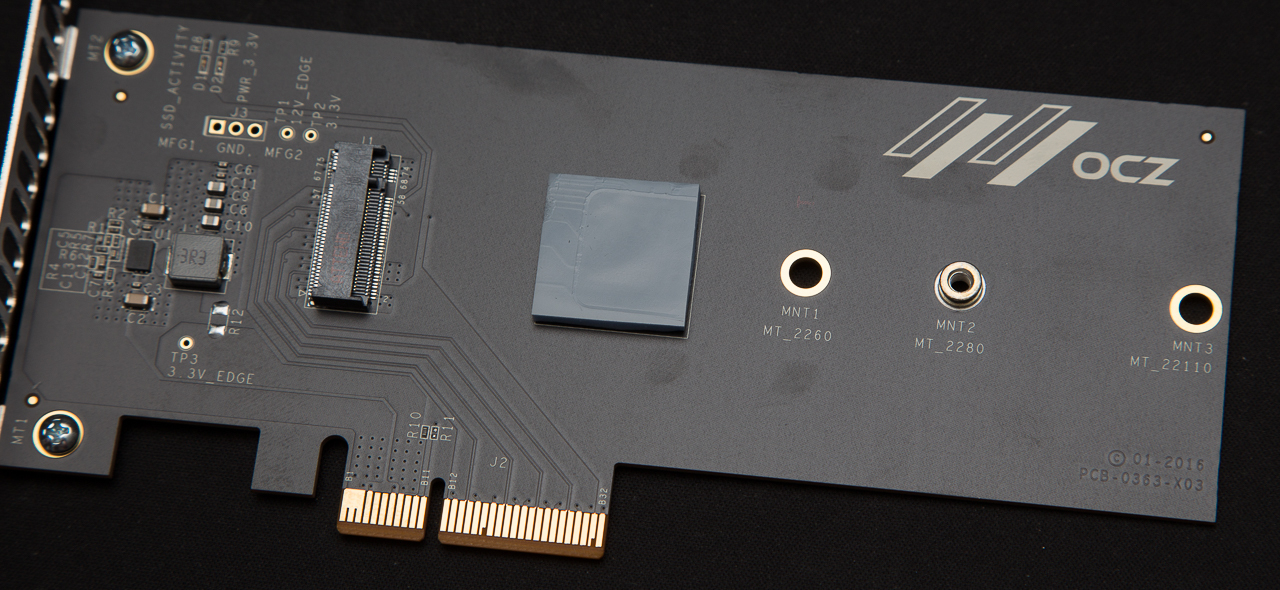
On the front side of the disc is a sticker with the OCZ logo and information from Toshiba about the device. Toshiba’s MLC memory hiding under the sticker was a 15-nm manufacturing process labeled TH58TFT1JFLBAEG - two 256 GB modules, each with 16 NAND devices, each with a capacity of 128 GB.
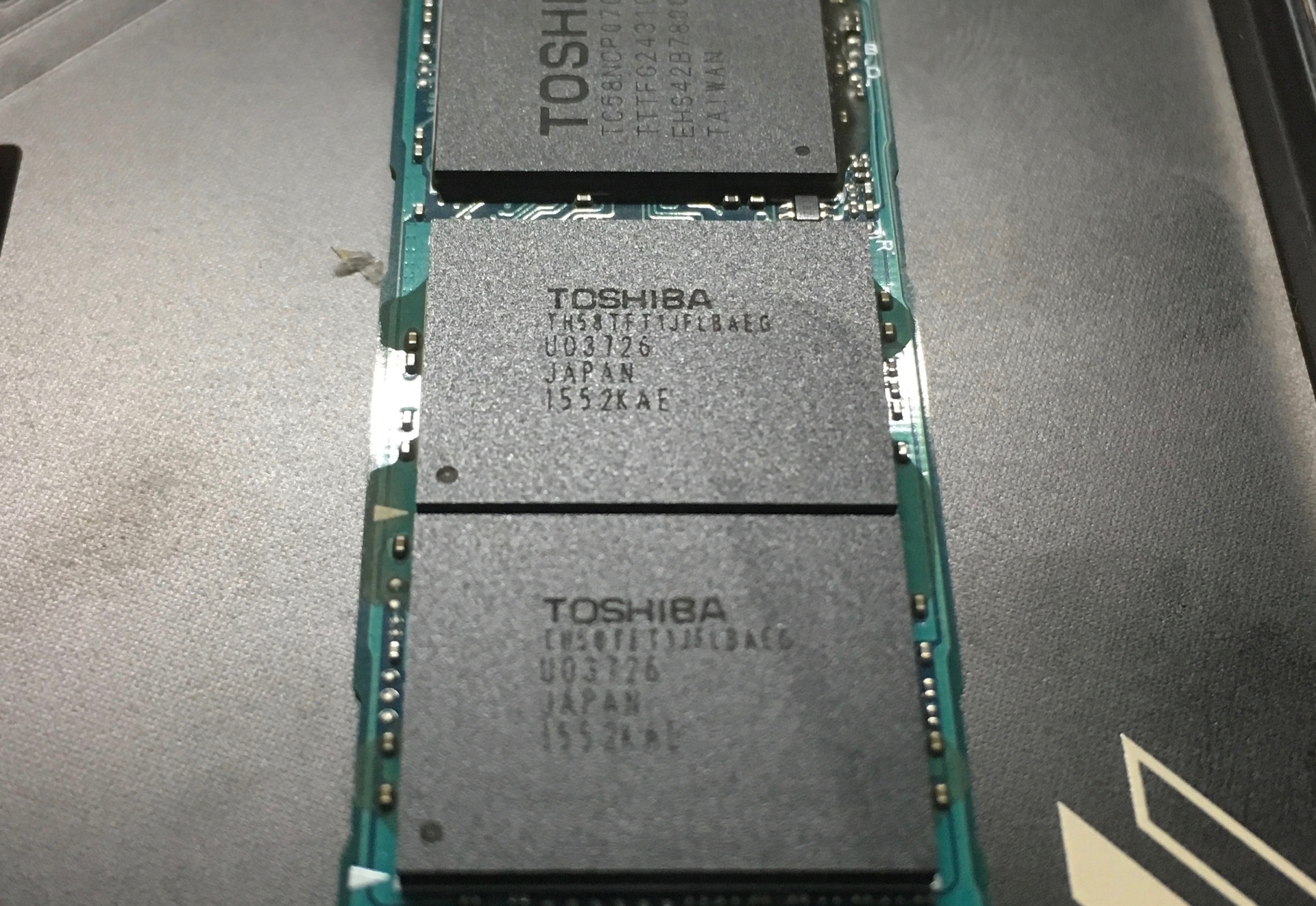
The TC58NCP070GSB controller, also known as the Toshiba proprietary Fujisan project, is actually a partner instance of the Marvell 88SS1093 Eldora with substantially improved firmware.
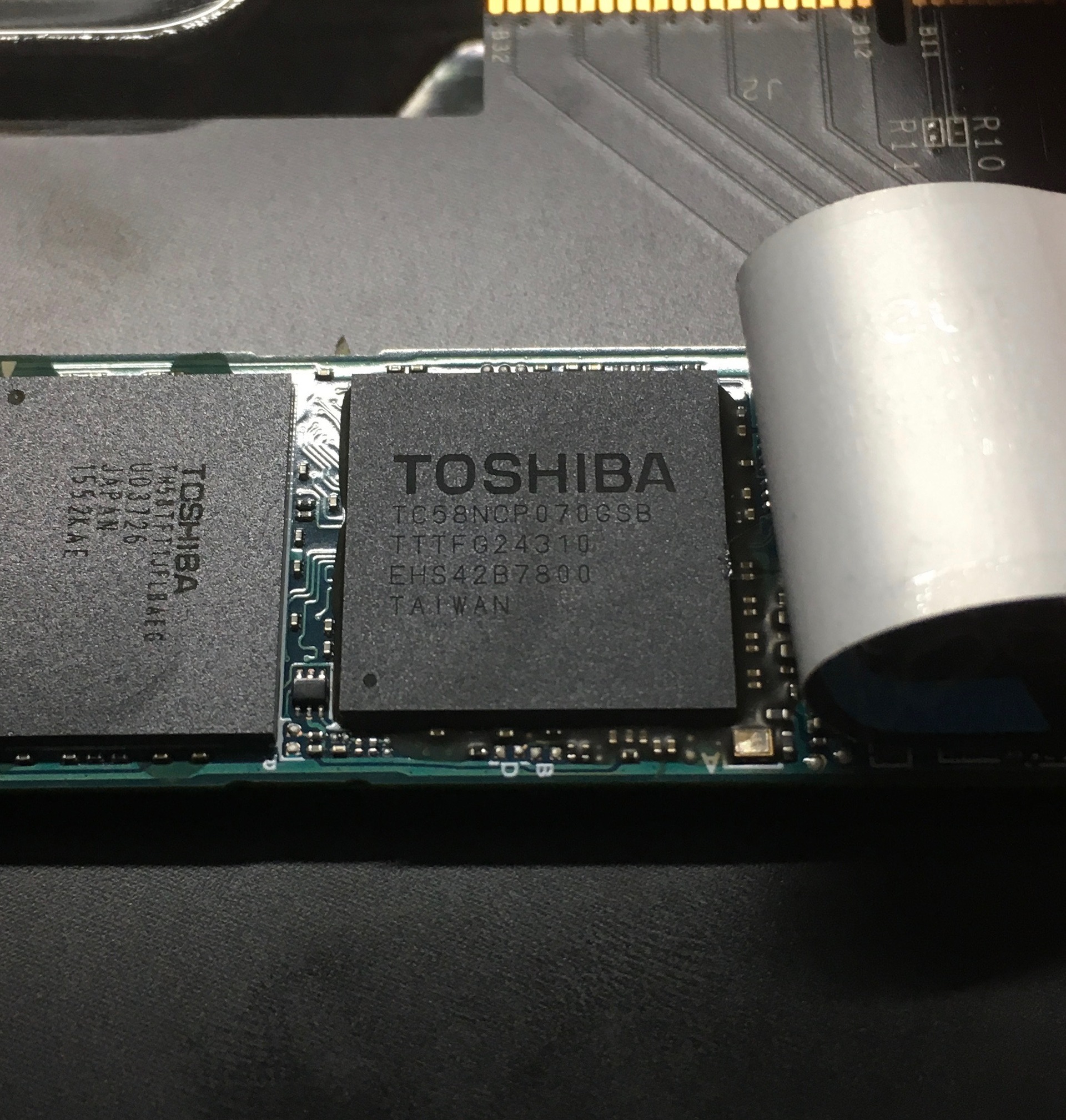
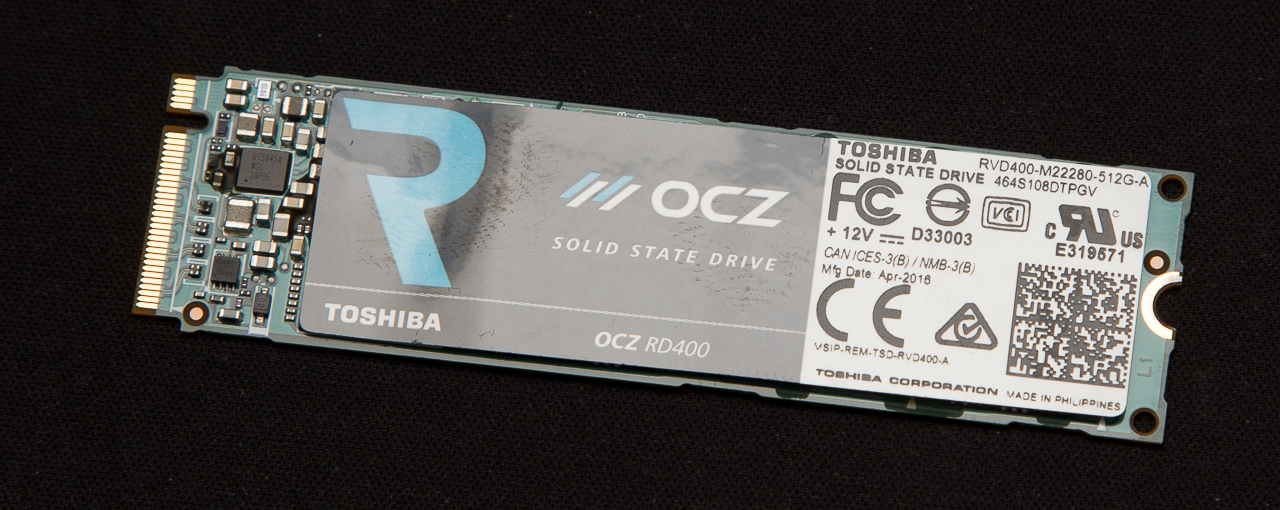
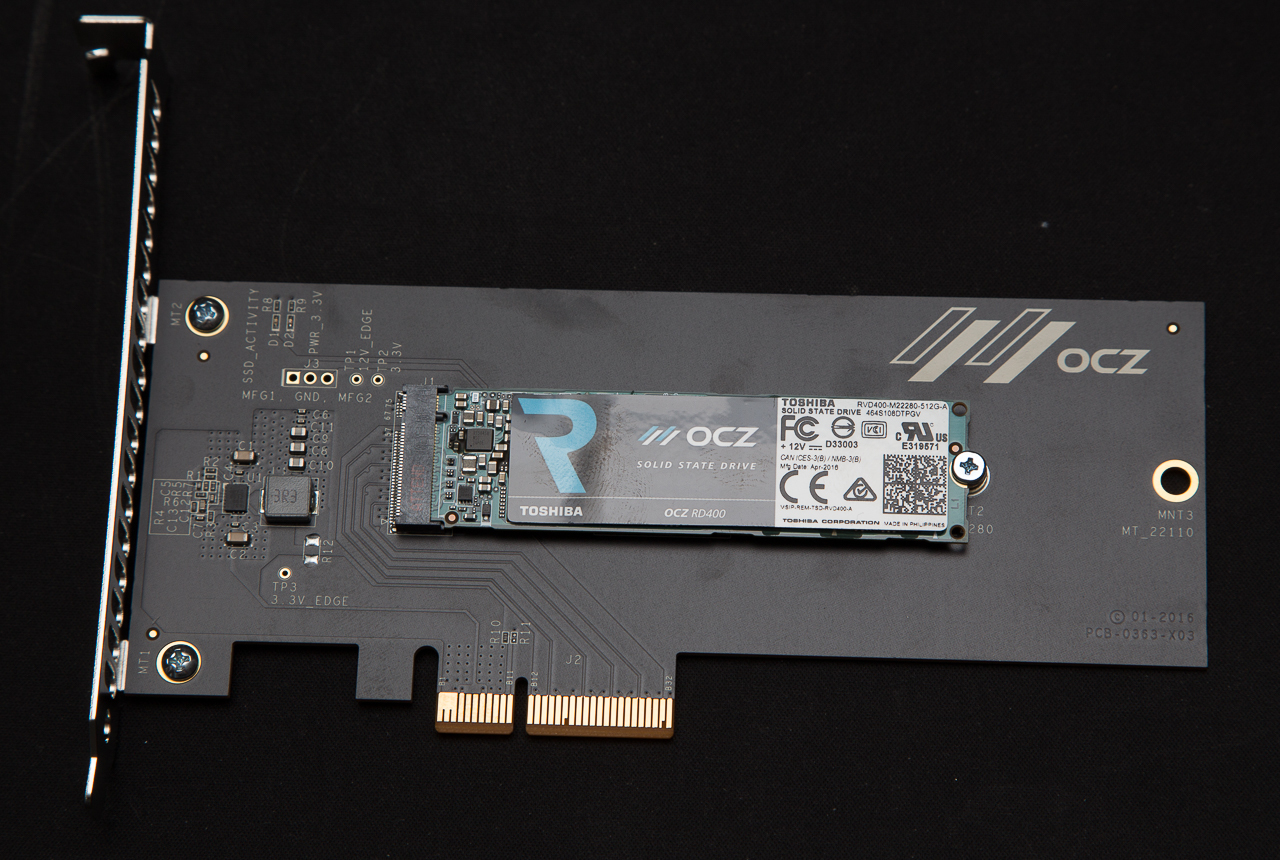
Test stand
- Processor: Intel Core i7-6700K
- Motherboard: ASUS Z170-Premium, Intel Socket 1151
- RAM: Geil Dragon RAM DDR4-4000, 2 * 8 Gb
- System SSD: HyperX Predator PCI-E SSD 480 GB
- Video card: ASUS ROG Strix GTX 1060 6 Gb
- Power Supply: Thermaltake DPS G RGB, 850W
- Operating system: Windows 10 Professional (64-bit) with the OCZ NVMe 1.2.126.843 driver installed

Before going directly to the numbers - I’ll say a few words about the proprietary software - SSD Utility, previously it was called SSD Guru.
In addition to the start window, where the drive’s operating mode is displayed (by the way, if you insert it into the lowest slot of the motherboard, as in the photo above, the mode can switch to PCI-E x2 - be careful), the drive’s temperature, and information about free space and the availability of a new one firmware, other interesting tabs are available.
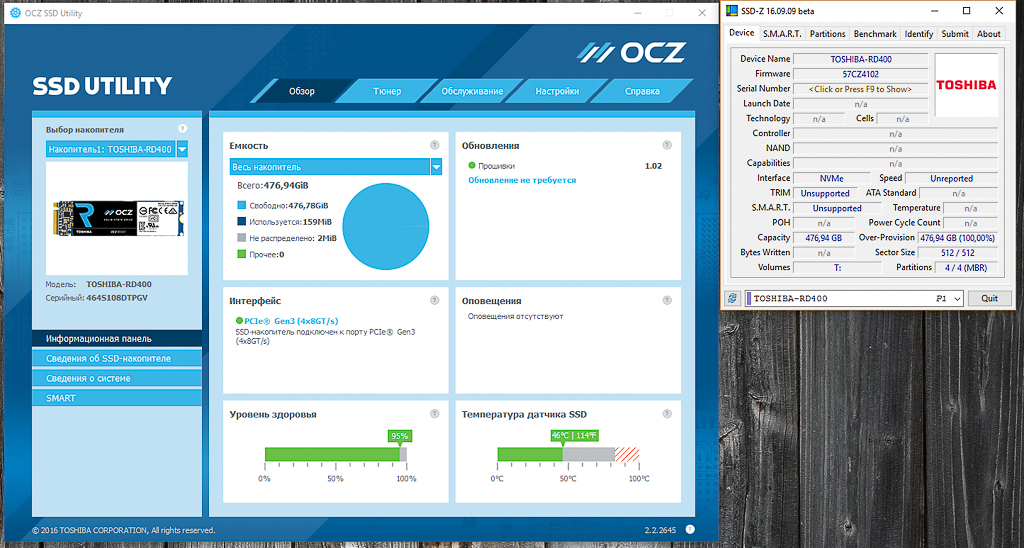
There is a quick test tab - the results on it coincide with those stated in the technical specifications.
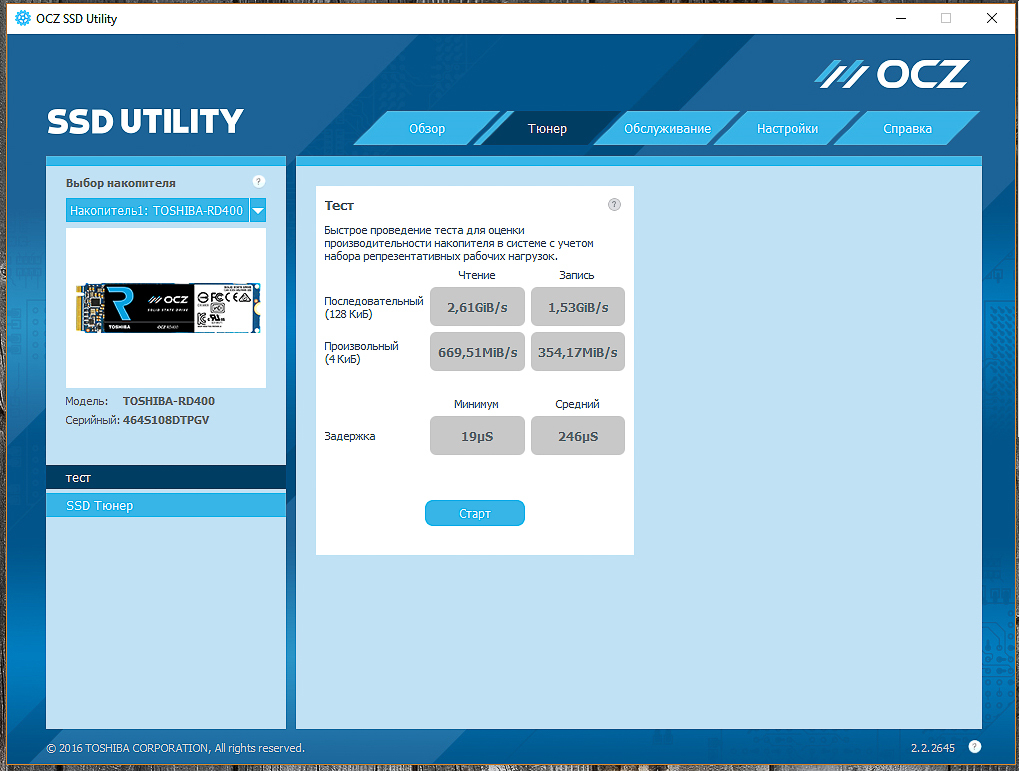
A separate bookmark for updating the firmware. At the time of testing, there were no fresh versions.
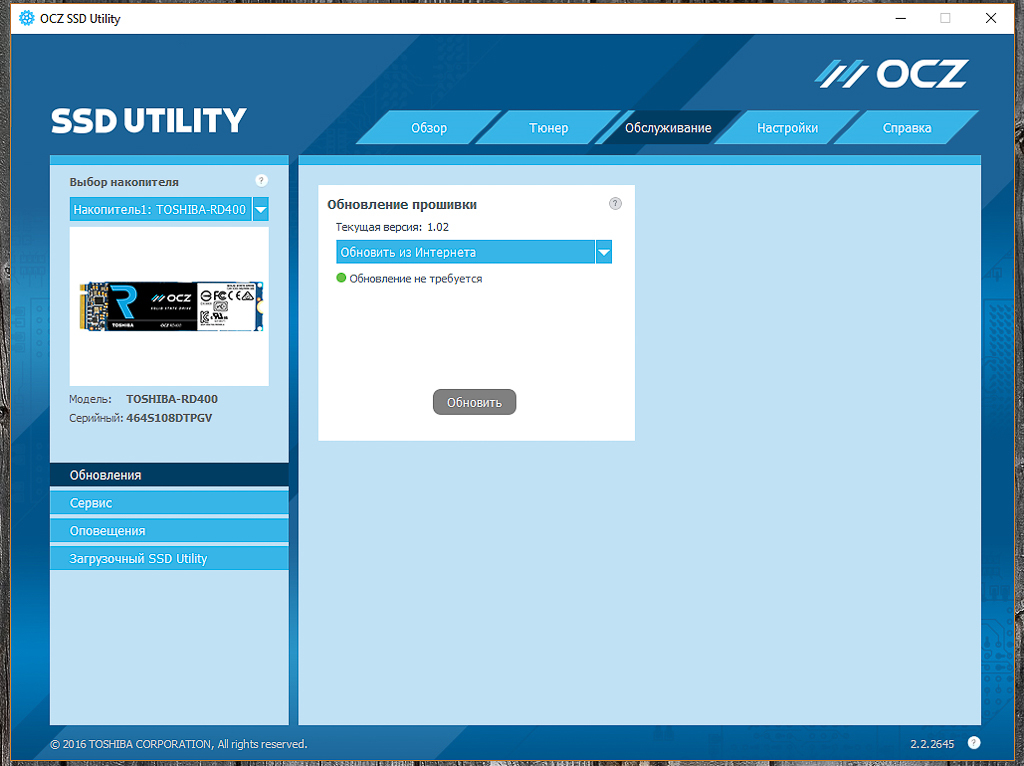
General settings of the utility - auto start, notifications, logs.

Directly from SSD Utility, you can send a message to OCZ technical support.
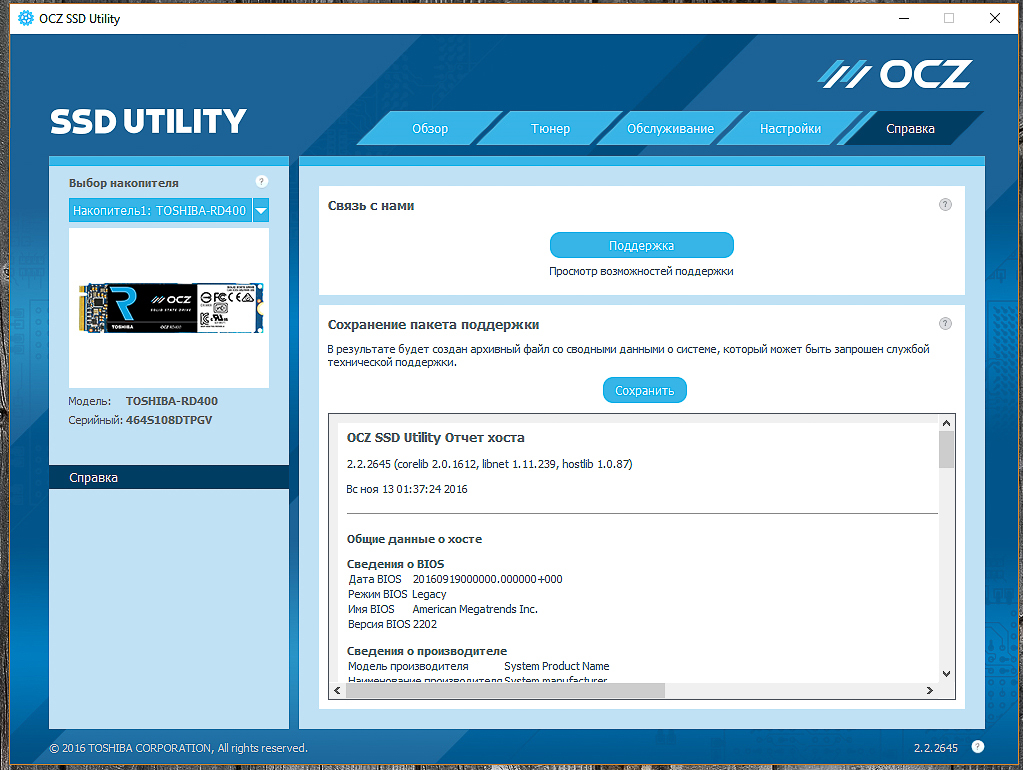
Information about the drive - the installed driver, serial number and more. By the way, on this tab you can see that in fact the OCZ RD400 is the twin brother of the Toshiba XG3.

Another tab is reserved for SMART.
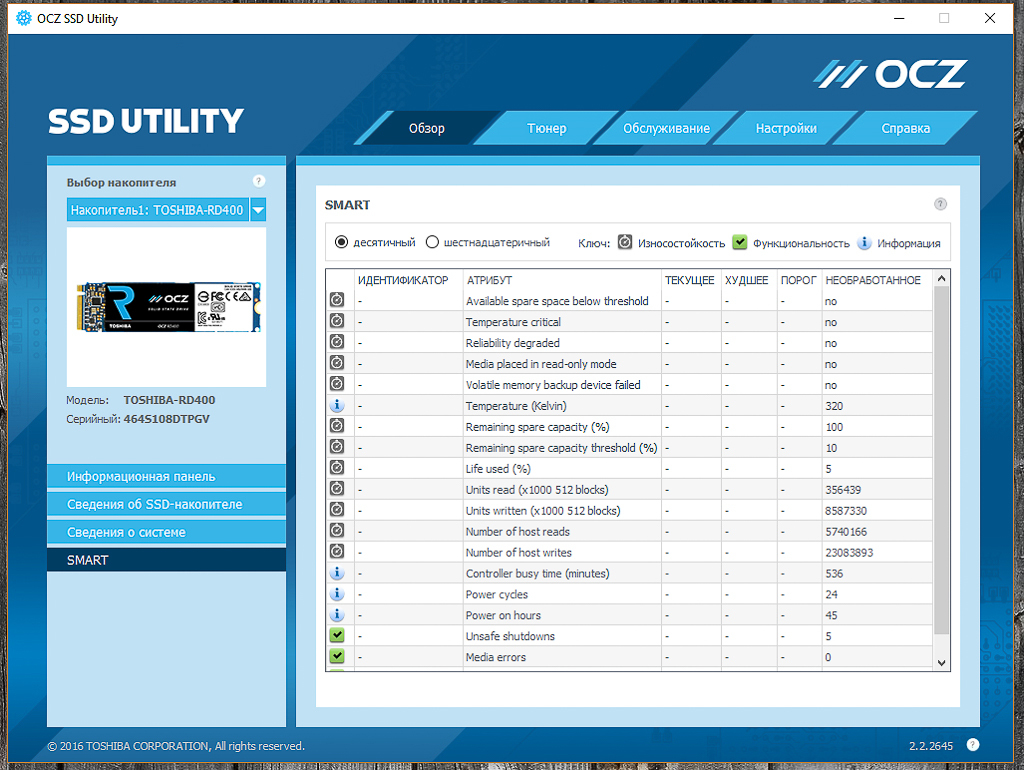
And the final one is general information about the system.

Testing methodology
The testing methodology assumes the following conditions: Windows 10 Professional operating system works correctly with solid-state drives - during tests, as well as during everyday work, TRIM works and is used by the system to clean the disk. Since the operating state is significantly different from the new SSD, before the test on the drive, a volume of data was recorded several times, twice the size of the disk itself.

ATTO disk benchmark 3.0.5
Favorite synthetics of all manufacturers, a regular test to assess the capabilities of drives. At the peak - 2.704 MB / s for reading and 1.617 MB / s for writing. Not bad at all.

AS SSD Benchmark 1.8.5636.36856
Subtest - Copy - I will use all three scenarios: ISO (two large files), Program (folder with a large number of small files) and Games (folder with an assortment of large and small files)
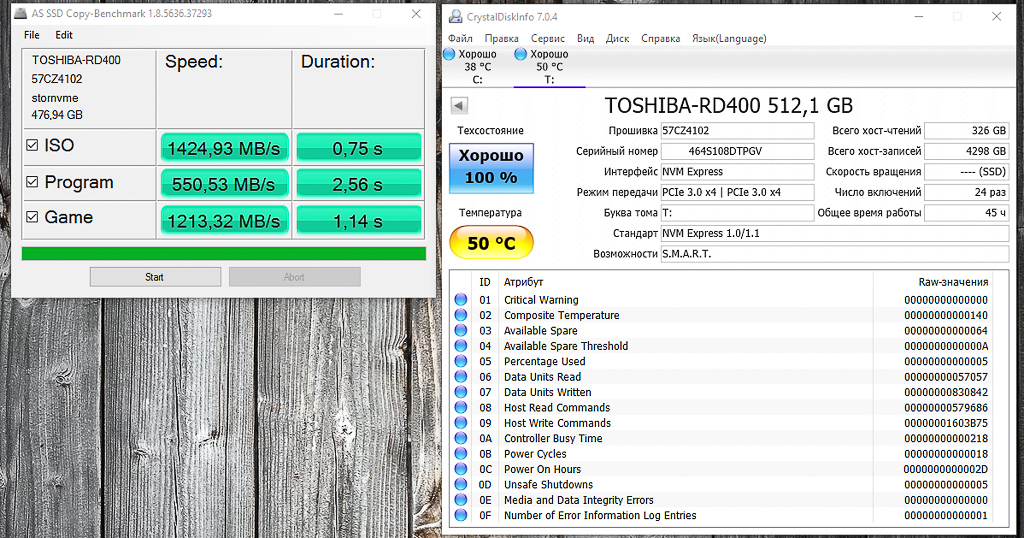
Crystal Disk Mark 5.1.2
This test allows you to evaluate the operation of the drive in four modes: linear read / write, read / write blocks in 4K, linear read / write with a depth of 32 teams, read / write blocks in 4K with a depth of 32 teams.

PC Mark 8 2.4.304
This synthetic test emulates the load of various applications, namely Adobe Master Suite and Microsoft Office, as well as two popular games - World Of Warcraft and Battlefield 3.
I will give a full layout of the tests below:
- World Of Warcraft - a situation is emulated when a user launches a game, logs in and starts gameplay. During the test, 390 MB of data is read and 5 MB of data is written. The largest number of random block read operations up to 64 KB.
- Battlefield 3 - a situation is emulated when a user launches a game, logs in, downloads a save game and starts playing. During the test, 887 MB of data is read and 28 MB of data is written. The largest number of operations is random reading of blocks up to 4 KB and up to 64 KB.
- Adobe Photoshop light - emulates the load of working with 14 files ranging in size from 4 to 17 MB. During the test, 313 MB of data is read and 2336 MB of data is written. The largest number of operations is sequential writing of blocks up to 128 KB.
- Adobe Photoshop heavy - the load of working with large files of raster graphics is emulated (creating a poster for printing in high resolution - the final layout in PSD is 1320 MB). During the test, 468 MB of data is read and 5640 MB of data is written. The largest number of operations is sequential writing of blocks up to 128 KB.
- Adobe Illustrator - emulates the load of working with vector graphics (creating a presentation from pictures created in Adobe Photoshop - add text, frames, etc. The total volume of the PDF file is 5.6 MB). During the test, 373 MB of data is read and 89 MB of data is written. The largest number of operations is random reading of blocks up to 64 KB.
- Adobe InDesign - a computer layout load is emulated (publishing a publication with a large number of illustrations - the total volume of the PDF file is 64.7 MB). During the test, 401 MB of data is read and 624 MB of data is written. The largest number of operations is random reading of blocks up to 4 KB and up to 64 KB.
- Adobe After Effects - emulates the load of working with a video editing program (fast video rendering, 1920 * 1080, 30 fps). During the test, 311 MB of data is read and 16 MB of data is written. The largest number of operations is random reading of blocks up to 4 KB and up to 64 KB.
- Microsoft Excel - the workload of working with spreadsheets is emulated (working with a table with 75 thousand cells). During the test, 73 MB of data is read and 15 MB of data is written. The largest number of operations is random reading of blocks up to 64 KB.
- Microsoft Word - the load of working with a text editor is emulated (a number of changes in a 57 MB file). During the test, 107 MB of data is read and 95 MB of data is written. The largest number of operations is random reading of blocks up to 64 KB.
- Microsoft Powerpoint - emulates the workload of the presentation wizard (creating a presentation with a large number of pictures - the total file size is 27.1 MB). The test reads 83 MB of data and writes 21 MB of data. The largest number of operations is random reading of blocks up to 64 KB.
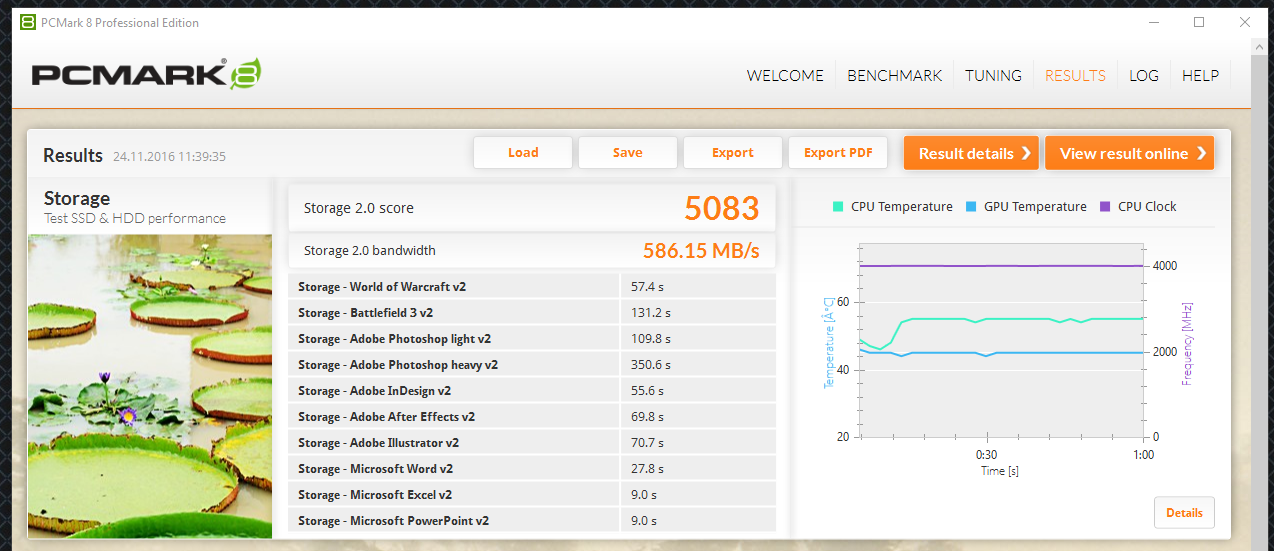
Performance Recovery Tests
In addition to the described options in the test package PC Mark 8, it is possible to conduct tests to restore performance under continuous load. The scheme of the package is as follows: first, the disk (unformatted, without partitions) is filled twice in blocks of 128 KB. Then the degradation phase follows: the disk is filled with random blocks of different sizes from 4 KB to 1 MB. Because blocks are not aligned, disk performance drops sharply. The first tests begin 10 minutes after filling the disk with random blocks. After passing the test, the filling process is repeated. Before each new test, a pause is made, which is five minutes longer than the previous one, that is, 15 minutes, 20 minutes and so on. This is repeated eight times. After this, tests of the stable phase begin. The script is repeated five times, between runs, a pause of 5 minutes is made without applying an additional load. This is followed by the performance recovery phase, when a five-minute pause is made between the scenarios to practice disk wiping.
Several applications are being tested in the package; I chose Adobe Photoshop (a heavy script).
I give four graphs: average access time, read speed, write speed, total disk speed.
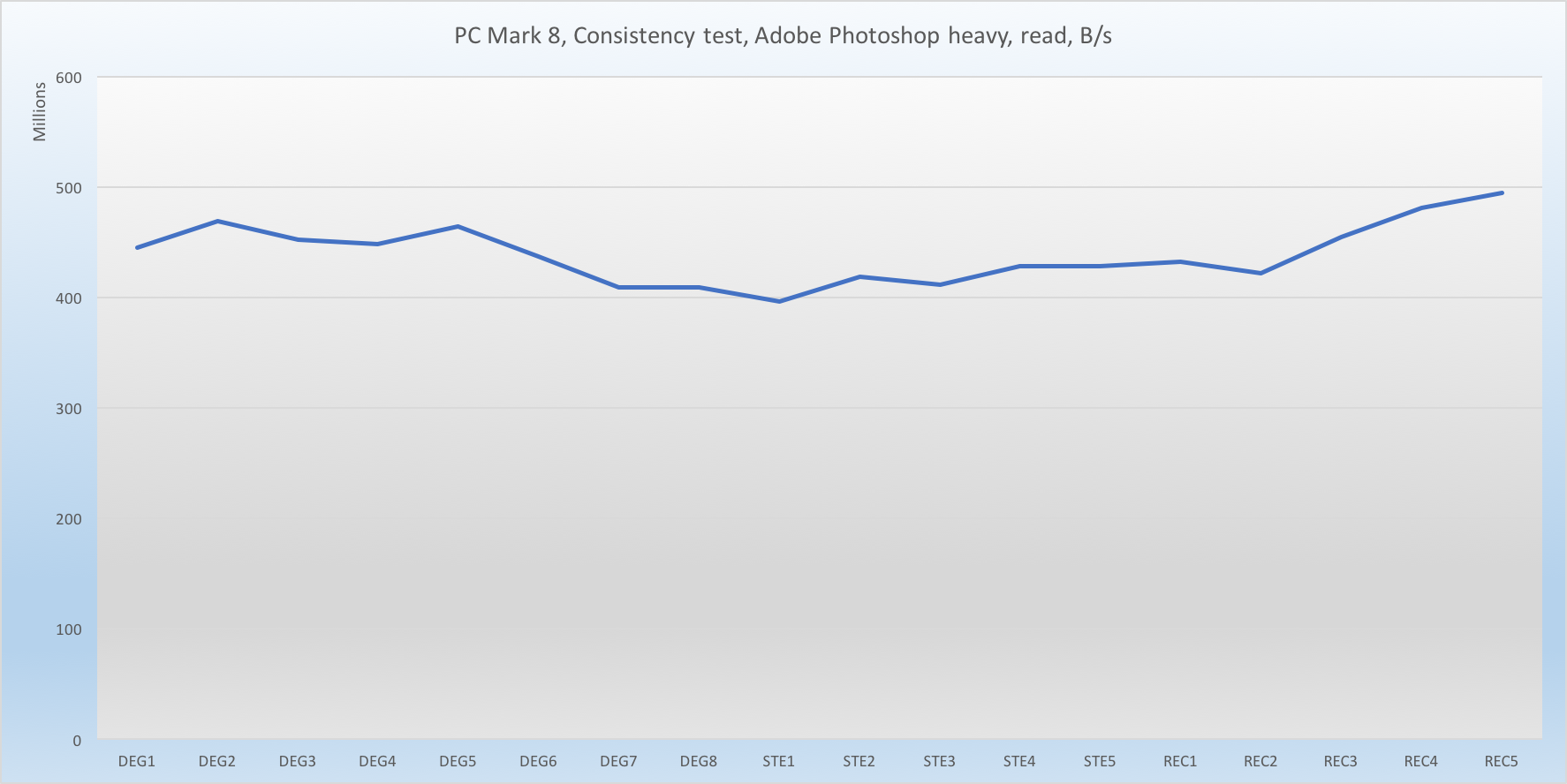
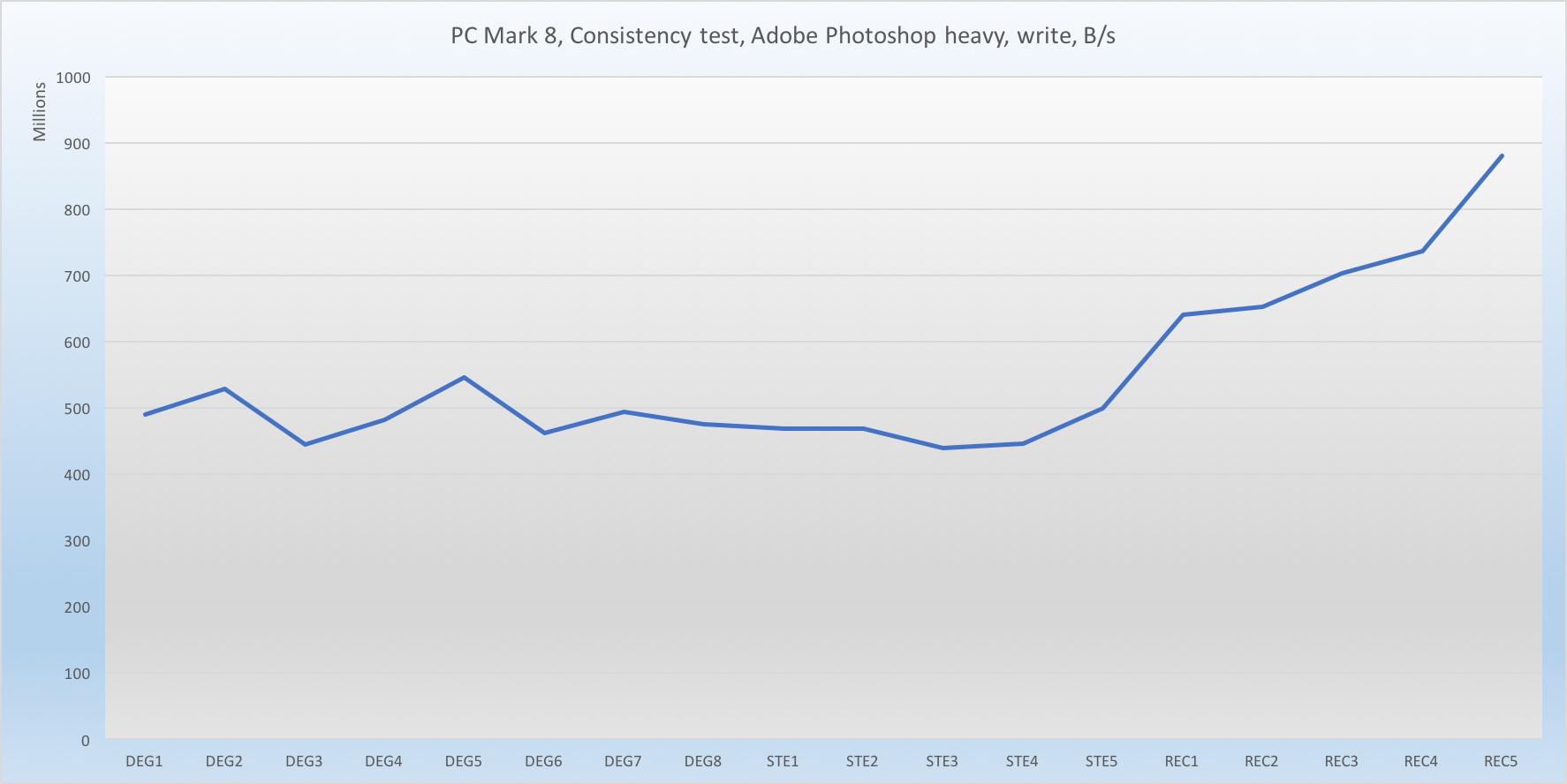
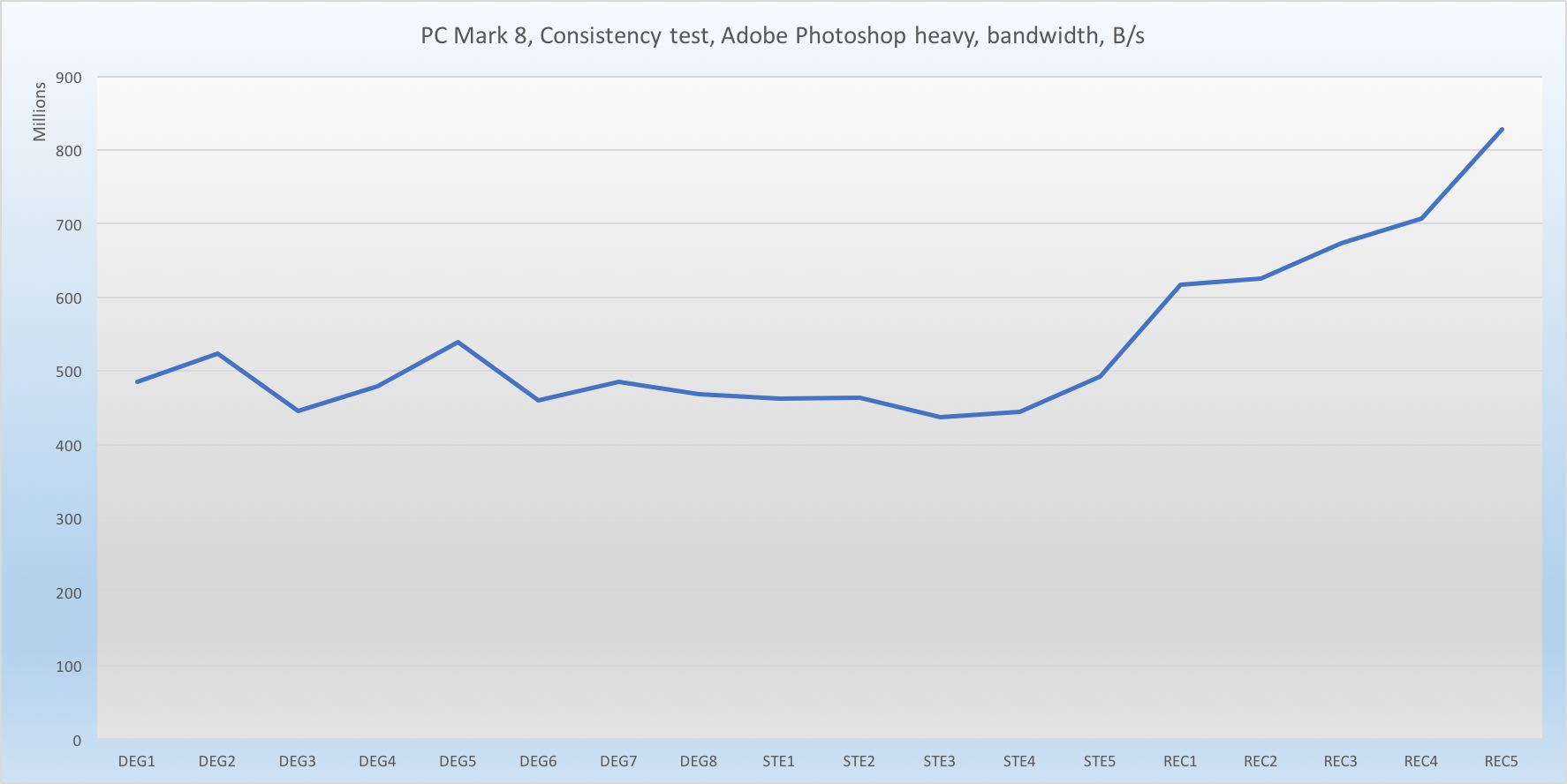
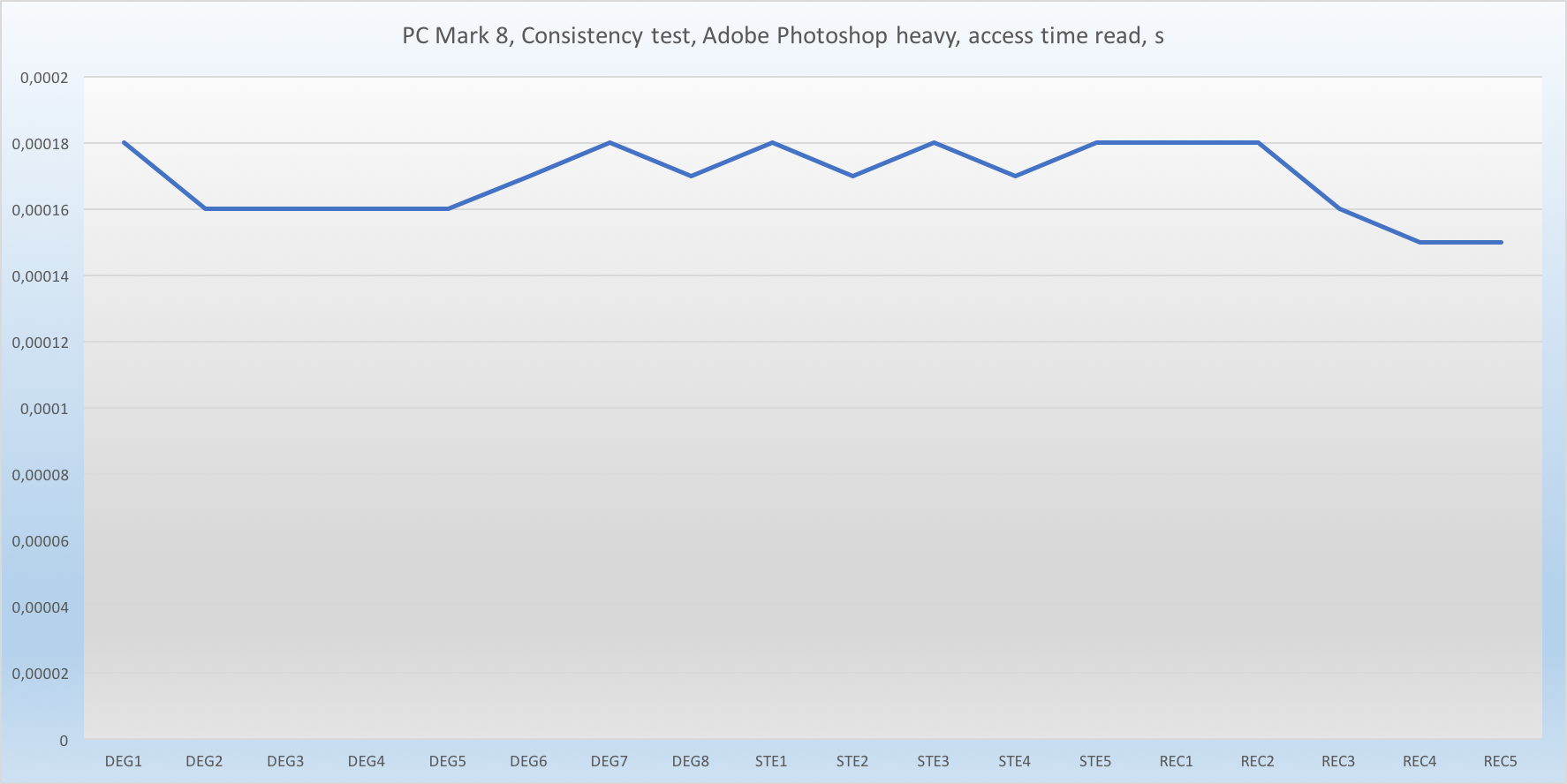
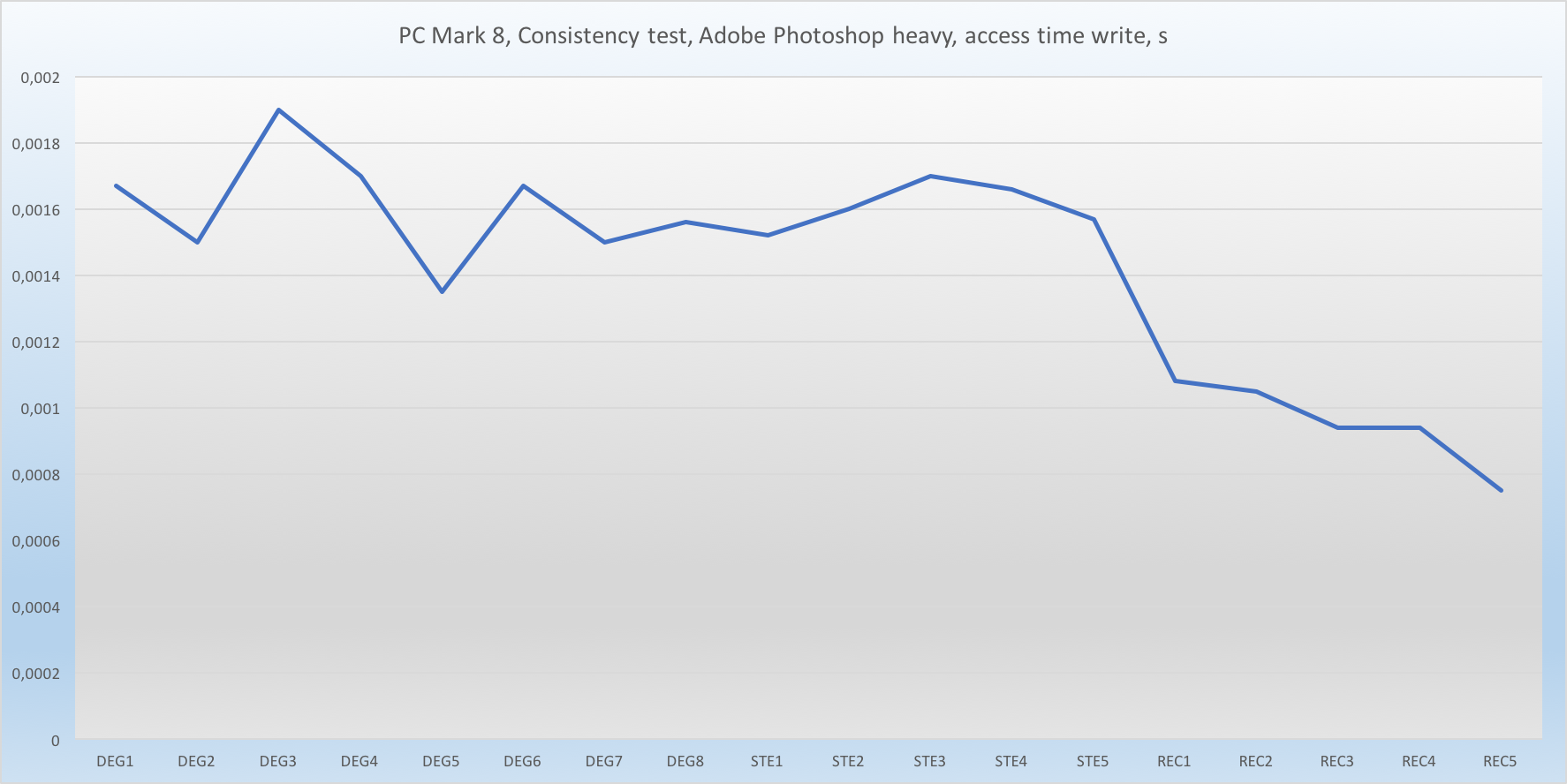
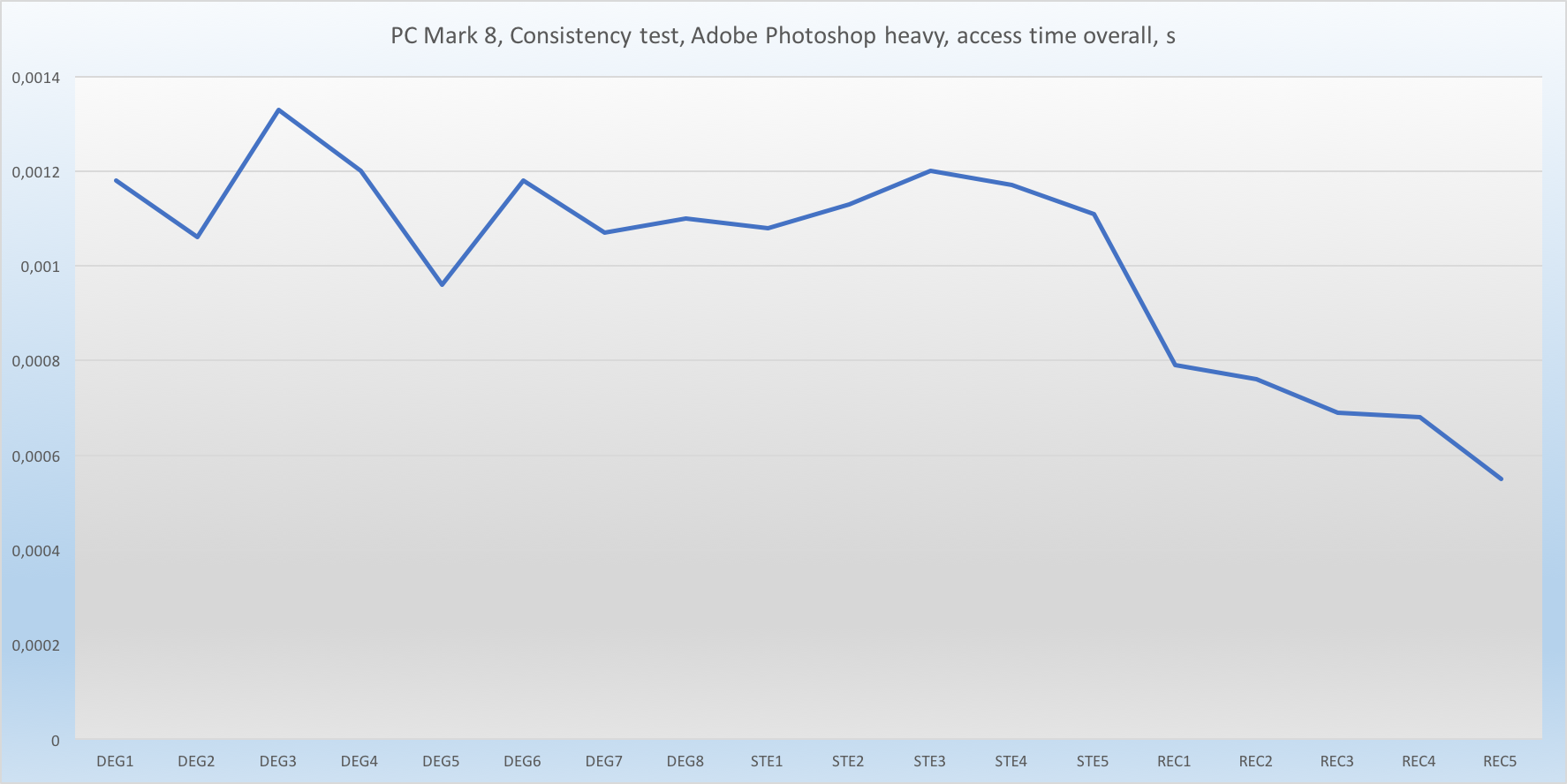
Conclusion: Very cool. Really really cool. The drive is very fast, at a price quite comparable to other PCI-E options, but it also supports the NVMe protocol, which significantly increases the speed of the system. For people who often work a lot with read / write operations, this is simply an indispensable option in high-performance workstations.
